- As many as 5 detainees are expected to be moved in the next few days, official says
- News comes less than a week after 4 detainees were repatriated to Afghanistan
- President Obama tells CNN he's "going to be doing everything I can to close it."
- Guantanamo Bay has held nearly 800 detainees; there are now 132
(CNN) -- The Obama administration hopes to transfer dozens of detainees from Guantanamo Bay in the next six months as part of a stepped-up effort to reduce the population there, according to a U.S. official.
As many as five detainees are expected to be moved from the detention facility in the next few days, with several more transfers anticipated in early 2015, the official said on condition of anonymity.

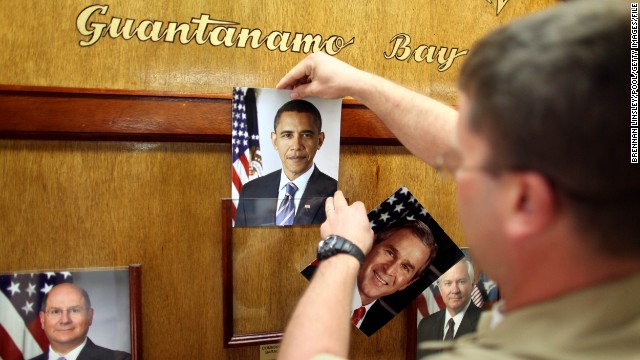 President Barack Obama signed an executive order on January 22, 2009, to close the detention facilities at Guantanamo Bay, Cuba, within a year. Nearly six years later, the prison for terrorism suspects remains open. Click through for a look inside the controversial facility. Here, President George W. Bush's official picture is replaced by Obama's in the lobby of the headquarters of the U.S. naval base at Guantanamo on January 20, 2009, the day the latter was sworn in as president.
President Barack Obama signed an executive order on January 22, 2009, to close the detention facilities at Guantanamo Bay, Cuba, within a year. Nearly six years later, the prison for terrorism suspects remains open. Click through for a look inside the controversial facility. Here, President George W. Bush's official picture is replaced by Obama's in the lobby of the headquarters of the U.S. naval base at Guantanamo on January 20, 2009, the day the latter was sworn in as president. 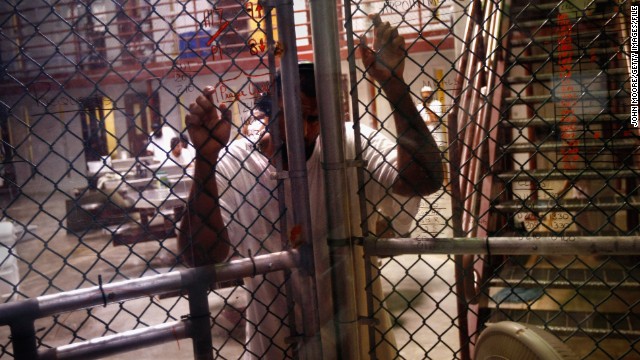 The U.S. naval base at Guantanamo Bay has held terror suspects since January 2002. Early in the war on terror, the Bush administration argued these detainees were "enemy combatants" who didn't have the protections accorded to prisoners of war under the Geneva Conventions. Here, a detainee stands at an interior fence at Guantanamo Bay in October 2009.
The U.S. naval base at Guantanamo Bay has held terror suspects since January 2002. Early in the war on terror, the Bush administration argued these detainees were "enemy combatants" who didn't have the protections accorded to prisoners of war under the Geneva Conventions. Here, a detainee stands at an interior fence at Guantanamo Bay in October 2009. 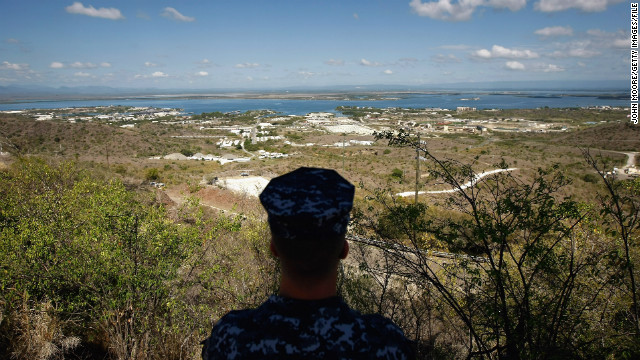 A Navy sailor surveys the U.S. naval base at Guantanamo Bay in October 2009. In December 2013, Congress passed a defense spending bill that makes it easier to transfer detainees out of the facility.
A Navy sailor surveys the U.S. naval base at Guantanamo Bay in October 2009. In December 2013, Congress passed a defense spending bill that makes it easier to transfer detainees out of the facility.  U.S. military guards move a detainee inside the detention center in September 2010. At its peak, the detainee population exceeded 750 men at Guantanamo.
U.S. military guards move a detainee inside the detention center in September 2010. At its peak, the detainee population exceeded 750 men at Guantanamo. 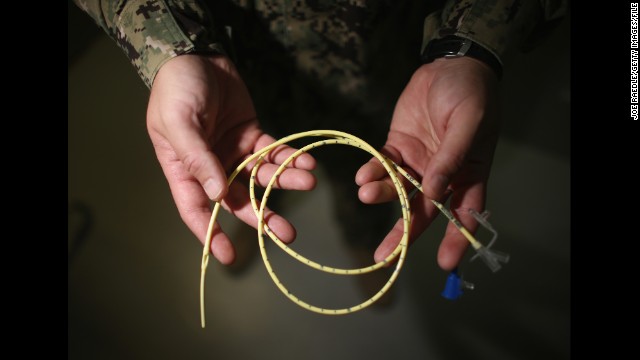 A military doctor holds a feeding tube used to feed detainees on a hunger strike at a Camp Delta hospital at Guantanamo in June 2013. In March 2013, the U.S. military announced that dozens of detainees had begun a hunger strike. By that June, more than 100 detainees were on a hunger strike, and more than 40 were being force-fed, military officials said.
A military doctor holds a feeding tube used to feed detainees on a hunger strike at a Camp Delta hospital at Guantanamo in June 2013. In March 2013, the U.S. military announced that dozens of detainees had begun a hunger strike. By that June, more than 100 detainees were on a hunger strike, and more than 40 were being force-fed, military officials said. 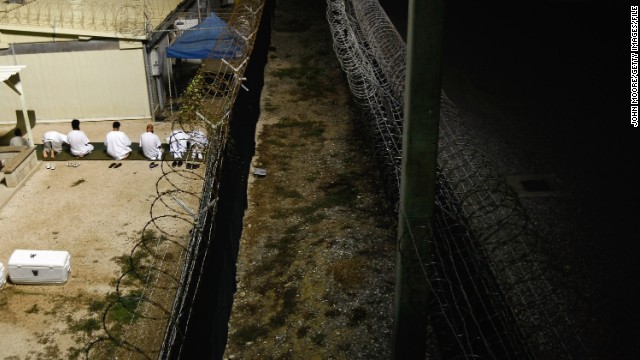 Muslim detainees kneel during early morning prayers in October 2009. Cells are marked with an arrow pointing in the direction of Mecca, regarded as Islam's holy city.
Muslim detainees kneel during early morning prayers in October 2009. Cells are marked with an arrow pointing in the direction of Mecca, regarded as Islam's holy city.  A soldier stands near a placard on the fence line of the detention facility in January 2012.
A soldier stands near a placard on the fence line of the detention facility in January 2012. 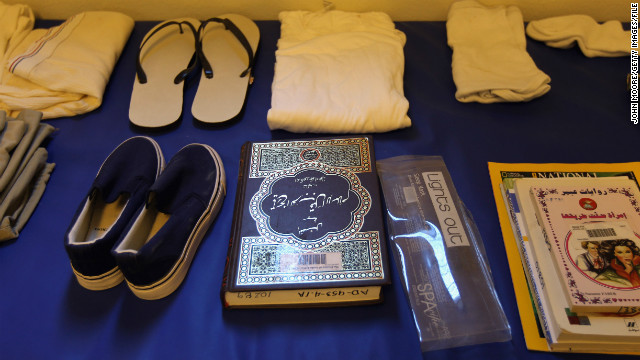 A Quran sits among a display of items isssued to detainees in September 2010. The suspects are given a prayer mat and a copy of the Muslim holy book as well as a toothbrush, soap, shampoo and clothing.
A Quran sits among a display of items isssued to detainees in September 2010. The suspects are given a prayer mat and a copy of the Muslim holy book as well as a toothbrush, soap, shampoo and clothing. 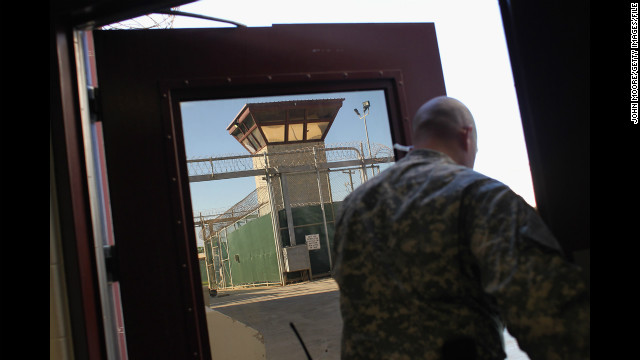 A U.S. military guard walks out of the maximum security section of the detention center in September 2010.
A U.S. military guard walks out of the maximum security section of the detention center in September 2010. 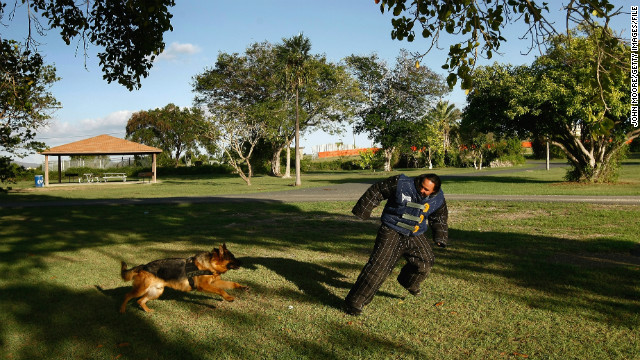 A German shepherd police dog undergoes training exercises in October 2009 at Guantanamo Bay.
A German shepherd police dog undergoes training exercises in October 2009 at Guantanamo Bay. 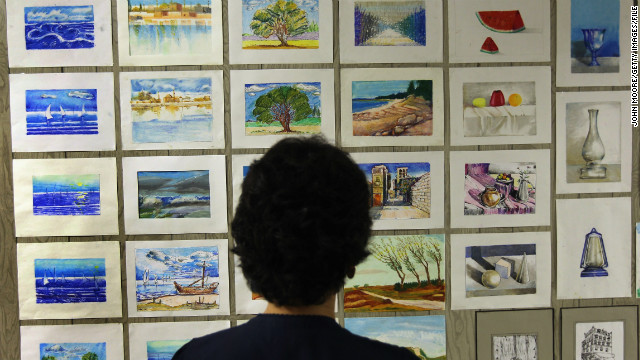 A camp librarian views artwork painted by detainees in September 2010.
A camp librarian views artwork painted by detainees in September 2010. 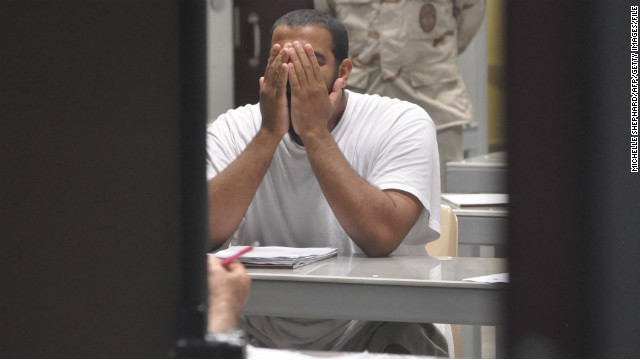 A detainee rubs his face while attending a "life skills" class inside the Camp 6 high-security detention facility in April 2009.
A detainee rubs his face while attending a "life skills" class inside the Camp 6 high-security detention facility in April 2009.  A seat and shackle await a detainee in the DVD room of the maximum security Camp 5 detention center in March 2010.
A seat and shackle await a detainee in the DVD room of the maximum security Camp 5 detention center in March 2010. 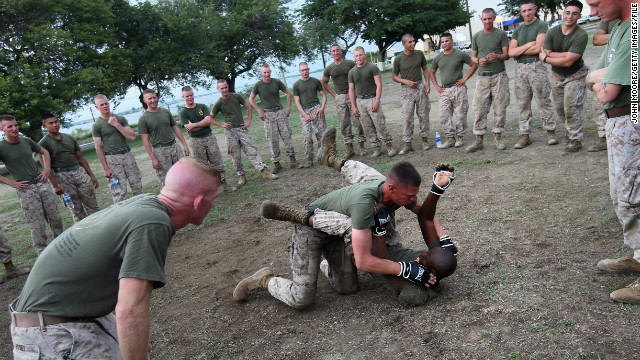 U.S. Marines join in martial arts training at the U.S. naval base in September 2010.
U.S. Marines join in martial arts training at the U.S. naval base in September 2010.  Members of the military walk the hallway of Cell Block C in the Camp 5 detention facility in January 2012.
Members of the military walk the hallway of Cell Block C in the Camp 5 detention facility in January 2012.  Guards move a detainee from his cell in Cell Block A of the Camp 6 detention facility in January 2012.
Guards move a detainee from his cell in Cell Block A of the Camp 6 detention facility in January 2012. 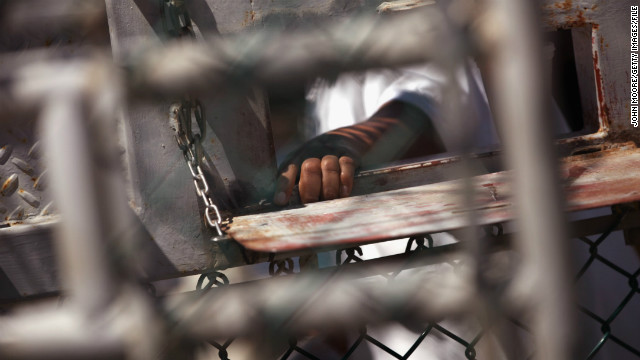 A detainee waits for lunch in September 2010. The cost of building Guantanamo's high-security detention facilities was reportedly about $54 million.
A detainee waits for lunch in September 2010. The cost of building Guantanamo's high-security detention facilities was reportedly about $54 million. 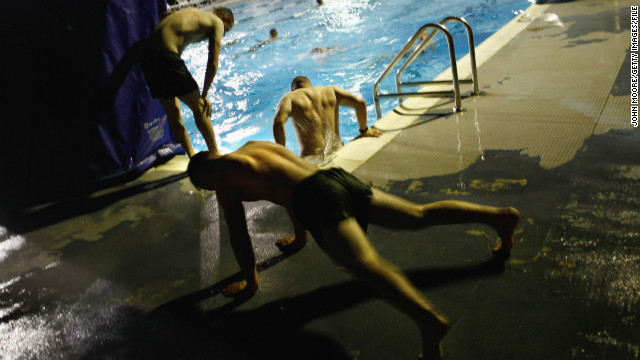 Marines get an early-morning workout at the U.S. naval base at Guantanamo Bay in October 2009.
Marines get an early-morning workout at the U.S. naval base at Guantanamo Bay in October 2009.  A bus carries military guards from their night shift at the detention center in September 2010.
A bus carries military guards from their night shift at the detention center in September 2010. 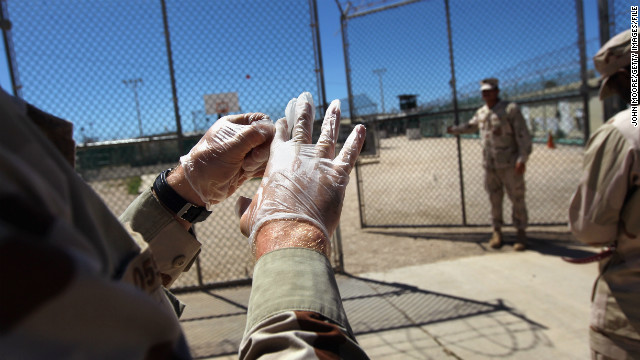 A military guard puts on gloves before moving a detainee within the detention center in September 2010.
A military guard puts on gloves before moving a detainee within the detention center in September 2010. 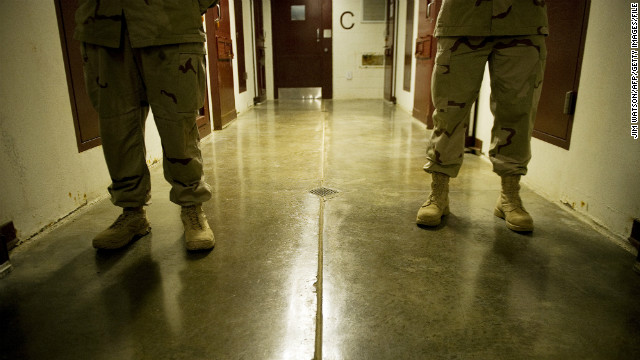 Members of the U.S. Navy move down the hallway of Cell Block C in the Camp 5 detention facility in January 2012.
Members of the U.S. Navy move down the hallway of Cell Block C in the Camp 5 detention facility in January 2012.  A U.S. military guard holds shackles before preparing to move a detainee in September 2010.
A U.S. military guard holds shackles before preparing to move a detainee in September 2010. 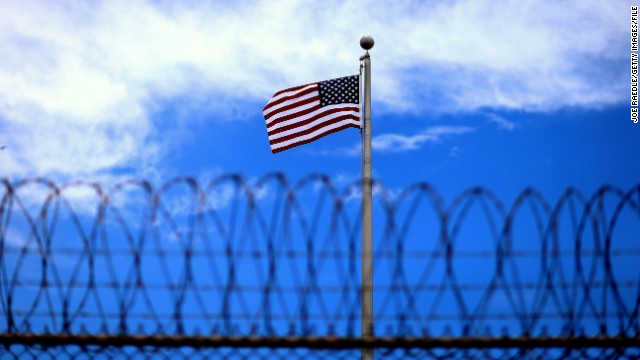 An American flag flies over Camp 6 at Guantanamo in June 2013.
An American flag flies over Camp 6 at Guantanamo in June 2013. Photos: Inside Guantanamo Bay
Photos: Inside Guantanamo Bay
 Photos: Inside Guantanamo Bay
Photos: Inside Guantanamo Bay The news comes less than a week after the United States announced it had repatriated four detainees from Guantanamo to Afghanistan, leaving 132 detainees at the U.S. naval base in southeastern Cuba.
President Barack Obama hinted at the intensified effort in an exclusive interview on CNN's "State of the Union" on Sunday, saying,
"It is something that continues to inspire jihadists and extremists around the world, the fact that these folks are being held," Obama said. "It is contrary to our values and it is wildly expensive. We're spending millions for each individual there. And we have drawn down the population there significantly."
Once a detainee is deemed no longer a risk, they are either transferred back to their country of origin, or a third country that is willing to take them.
Sixty-four of the 132 remaining detainees have been ruled eligible for transfer.
Of the 64 eligible, 54 are from Yemen. But the United States is not willing, at this point, to send them back to Yemen because of concerns that the government -- under pressure from al Qaeda and Houthi militants -- cannot ensure they do not join al Qaeda elements there. The administration for the last several months has been trying to find a country that will take the Yemenis and provide security and human rights assurances for them.
The official said there are ongoing talks to try to find countries to take all 64 detainees approved for transfer.
An additional 20 detainees from Yemen still are considered too dangerous to be transferred, as are several detainees accused of involvement in the 9/11 attacks, including Khalid Sheikh Mohammed.
The number of remaining detainees is down significantly from the nearly 800 that had been held there after Guantanamo was repurposed to hold detainees from the United States' war on terror.
The administration of then-President George W. Bush claimed that, since Gitmo detainees weren't held on American soil, they could be considered "enemy combatants" and be denied some legal protections. Almost all of the 800 detainees were held without charges.
This legal limbo, as well as allegations of torture and other mistreatment, spurred criticism of the facility popularly known as Gitmo. Obama pledged to shut it down as part of his 2008 campaign, but saw his plans thwarted by opposition from Congress, which among other things prevented him from transferring remaining detainees to U.S. prisons.























No comments:
Post a Comment